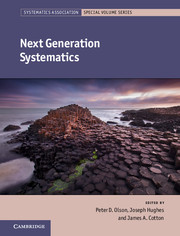Book contents
- Frontmatter
- Contents
- List of contributors
- Introduction: studying diversity in an era of ubiquitous genomics
- Part I Next Generation Phylogenetics
- Part II Next Generation Biodiversity Science
- Part III Next Generation Challenges and Questions
- 10 Perspective: Systematics in the age of genomics
- 11 Perspective: The role of next generation sequencing for integrative approaches in evolutionary biology
- 12 Next generation apomorphy: the ubiquity of taxonomically restricted genes
- 13 Utilizing next generation sequencing for evo-devo study of plant traits
- 14 An NGS approach to archaeobotanical museum specimens as genetic resources in systematics research
- 15 From sequence reads to evolutionary inferences
- Index
- Systematics Association Special Volumes
- Plate section
- References
14 - An NGS approach to archaeobotanical museum specimens as genetic resources in systematics research
from Part III - Next Generation Challenges and Questions
Published online by Cambridge University Press: 05 June 2016
- Frontmatter
- Contents
- List of contributors
- Introduction: studying diversity in an era of ubiquitous genomics
- Part I Next Generation Phylogenetics
- Part II Next Generation Biodiversity Science
- Part III Next Generation Challenges and Questions
- 10 Perspective: Systematics in the age of genomics
- 11 Perspective: The role of next generation sequencing for integrative approaches in evolutionary biology
- 12 Next generation apomorphy: the ubiquity of taxonomically restricted genes
- 13 Utilizing next generation sequencing for evo-devo study of plant traits
- 14 An NGS approach to archaeobotanical museum specimens as genetic resources in systematics research
- 15 From sequence reads to evolutionary inferences
- Index
- Systematics Association Special Volumes
- Plate section
- References
Summary
Introduction
The study of evolution most typically involves inferring past events on the basis of evidence from extant organisms. There are a number of challenges associated with this, such as uncertainties about the precise time of origin of character states, the rate of molecular evolution and confounding effects of population processes. Accessing evolutionary information directly from the fossil and sub-fossil record – in fact, any past period from which a measurable change has occurred – is therefore extremely useful in addressing these uncertainties. Museum, archaeology department and herbarium collections are the ‘banks’ of biomolecular information from which our scientific understanding of such processes can be extrapolated. Precautions taken to preserve biological material such as controlled environments, tissue-specific storage materials and the conservation of depositional environments are often conducive to long-term survival of genetic material. Consequently, these biomolecular banks hold material with a wide geographical and temporal range, often outside the typical age range of material used in phylogenetic analyses, as well as genetic diversity that is rare or lost in the living world. The advent of ancient biomolecular analyses in the 1990s was a technological milestone in this respect, in which oligogenic analyses based on one or a few genes enabled the reconstruction of extinct stages of phylogenies, such as the renowned placement of the thylacine among dasyuroid marsupials using evidence from cytochrome b DNA sequences (Krajewski et al. 1992; 1997).
NGS allows deep sequencing of single PCR targets, so generating systematic data for thousands or millions of organisms (Sogin et al. 2006). It also facilitates the study of multiple PCR targets of exons, introns, non-coding regions, mRNA transcripts or even complete genomic organization between organisms allowing a much greater depth of understanding in genetic phylogenies than could be gained from a handful of genes or simple morphological analysis (Horner et al. 2010). For the most part, NGS technology has been applied to extant species in systematics research. The applicability of NGS to sub-fossil material was first demonstrated by Poinar et al. (2006) in permafrost preserved mammoth bones. Subsequently, the application of NGS to generate data directly from historical, archaeological or paleontological sources holds the potential to view genomic evolution in real time.
- Type
- Chapter
- Information
- Next Generation Systematics , pp. 282 - 304Publisher: Cambridge University PressPrint publication year: 2016

